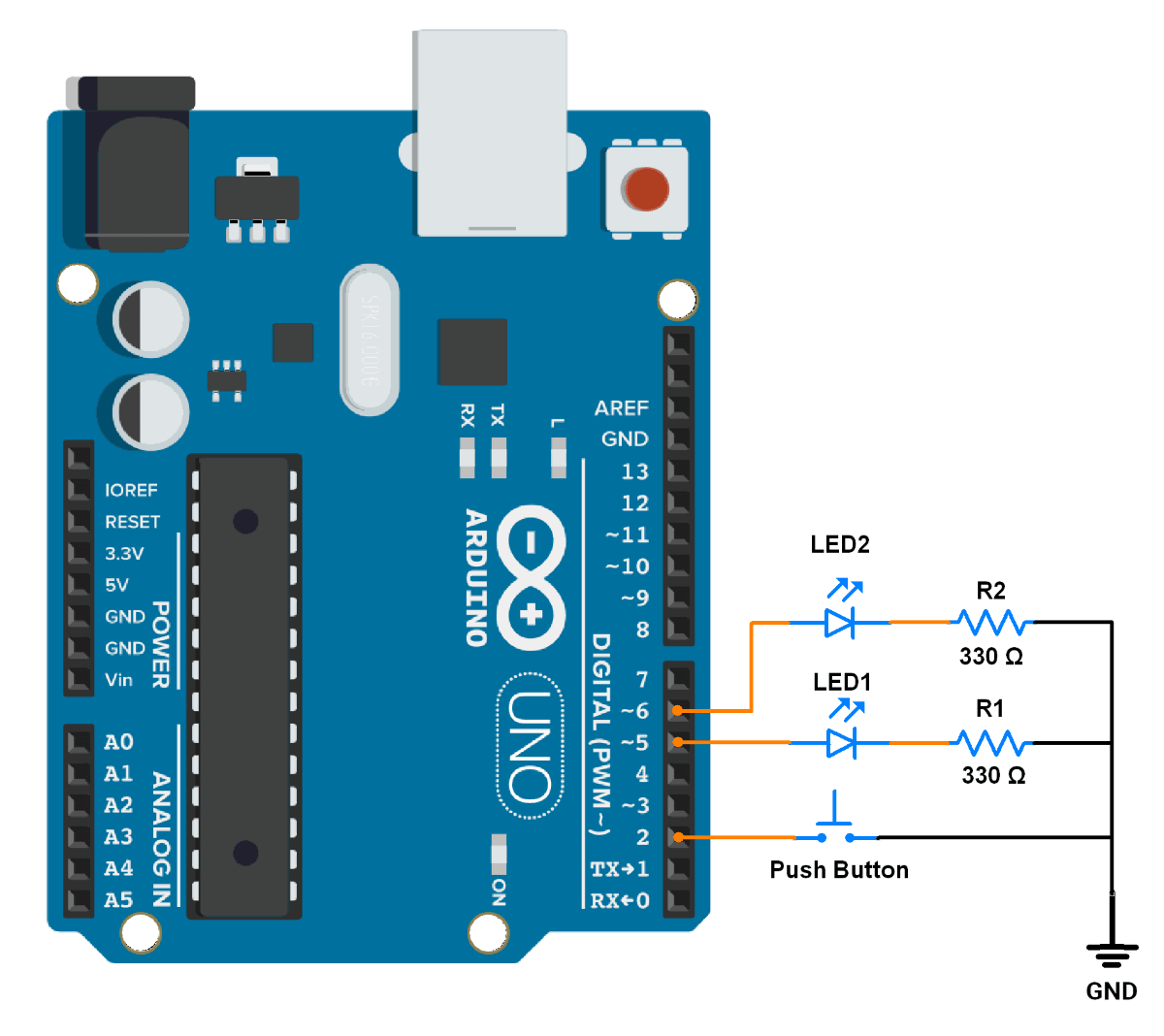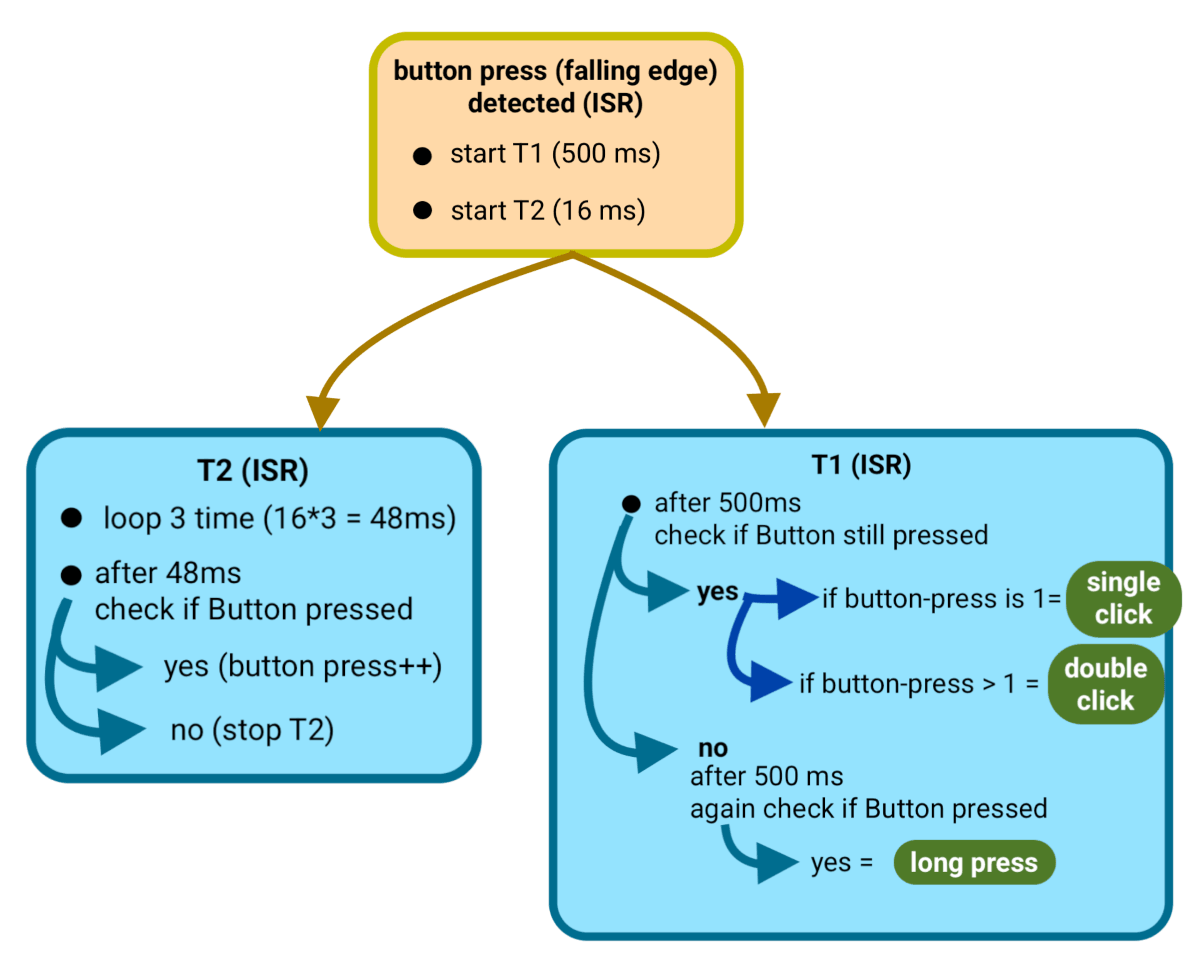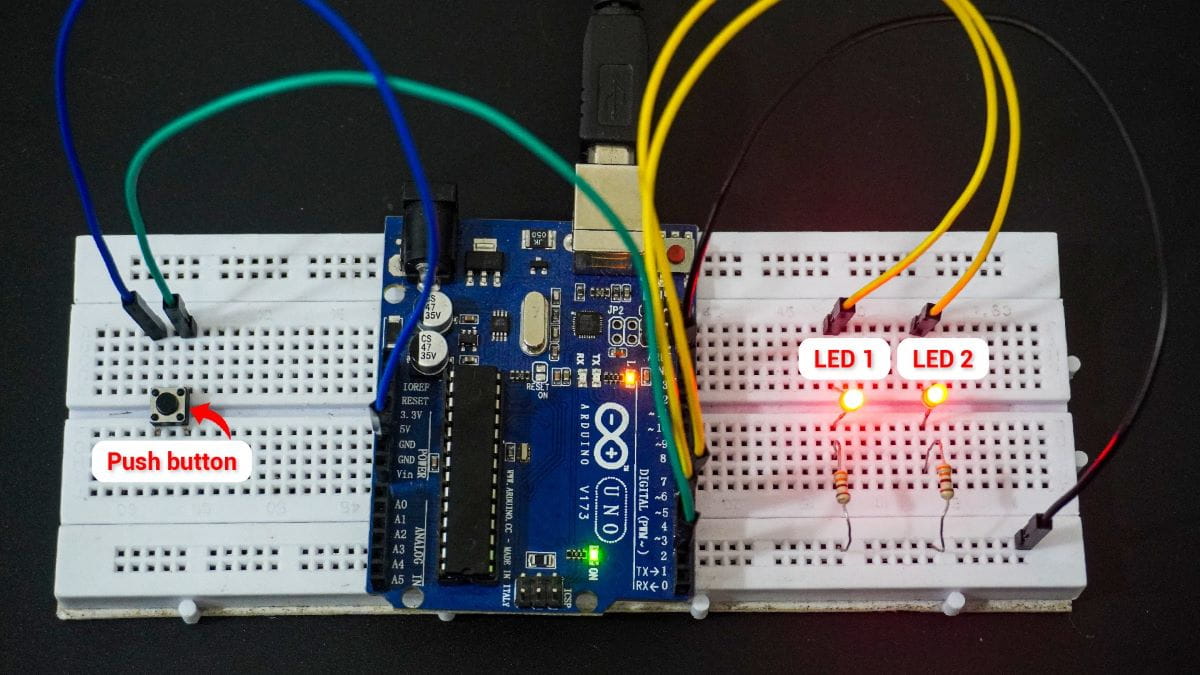Loading...
62. Single Double and Long Press with Interrupts
We have to detect single, double, and long press events from the push button
Control LED1 and LED2 based on the press events
- Single press: Toggle LED1
- Double press: Toggle LED2
- Long press (over 1 second): Turn off both LED1 and LED2
Hardware Connection
- Push button → Pin 2 (using internal pull-up)
- LED1 → Pin 5
- LED2 → Pin 6
- Use a 330 Ohm resistor for each LED to limit current to 10mA
Circuit Connection

Firmware
What do we have to achieve?
- The system detects single, double, and long button presses using an Arduino UNO.
- Toggles LED1 and LED2 based on the type of press.
- Use timers and interrupts for button press detection and debounce logic.
Logic to detect button presses

What is Debouncing logic?
- When a button is pressed
- Ideally, Wait for 50 ms → check if the button is still pressed → click++.
- But, the maximum limit
timer_2can count is 16 ms. Thus, we will loop 3 times to complete the 48ms wait time. - After waiting 48ms → check if the button is pressed → if yes, we will increment the button-click count.
- If a noise spike occurs,
Timer_2is reset to 0 again. - Thus, button-press count will be updated only after a stable 48ms button press is detected.
How do we detect the type of button press?
- When a button is pressed
- Start Timer_1 for 500 ms.
- In this 500 ms, we are monitoring constantly for a button press. If a button press occurs we update the button-press count.
There are 2 cases after 500ms occurs
- After 500ms (button released)
- If the button is pressed 1 time → register single click
- If the button is pressed more than 1 time → register double click
- After 500ms (button still pressed)
- Wait for another 500ms
- After 500ms, if the button still pressed → register as long press
Code
#define LED1_PIN 5 // Pin for LED1
#define LED2_PIN 6 // Pin for LED2
#define BUTTON_PIN 2 // Pin for the button
volatile bool isT1running = false; // Flag to indicate if Timer1 is running
volatile bool isT2running = false; // Flag to indicate if Timer2 is running
volatile int clicksCount = 0; // Counter for button clicks
volatile int t1Counter = 0; // Counter for Timer1 compare events
volatile int t2Counter = 0; // Counter for Timer2 compare events
void setup() {
pinMode(LED1_PIN, OUTPUT); // Set LED1 pin as output
pinMode(LED2_PIN, OUTPUT); // Set LED2 pin as output
pinMode(BUTTON_PIN, INPUT_PULLUP); // Set button pin as input with pull-up resistor
// Configure Timer1 for a 500ms timeout
TCCR1A = 0; // Set Timer1 to Normal mode
TCCR1B = 0; // Stop Timer1
OCR1A = 31249; // Set compare value for 500ms
TCNT1 = 0; // Reset Timer1 counter
TIMSK1 = (1 << OCIE1A); // Enable Timer1 Compare Match A interrupt
// Configure Timer2 for debounce logic
TCCR2A = (1 << WGM21); // Set Timer2 to CTC mode
TCCR2B = 0; // Stop Timer2
OCR2A = 255; // Set compare value for debounce duration
TCNT2 = 0; // Reset Timer2 counter
TIMSK2 = (1 << OCIE2A); // Enable Timer2 Compare Match A interrupt
// Configure external interrupt for the button (INT0)
attachInterrupt(digitalPinToInterrupt(BUTTON_PIN), ISR_INT0, FALLING);
// Enable global interrupts
sei();
}
void loop() {
while (true) {
//In this loop Microcontroller is busy in monitoring and performing important tasks constantly.
}
}
// Interrupt Service Routine for button press (INT0)
void ISR_INT0() {
// If Timer1 is not running and no clicks are counted yet, start Timer1
if (!isT1running && clicksCount == 0) {
TCCR1B = (1 << WGM12) | (1 << CS12); // Start Timer1
isT1running = true;
}
// Start Timer2 for debounce logic if it's not running
if (!isT2running) {
TCCR2B = (1 << CS22) | (1 << CS21) | (1 << CS20); // Start Timer2
isT2running = true;
}
}
// Interrupt Service Routine for Timer2 (Debounce logic)
ISR(TIMER2_COMPA_vect) {
t2Counter++;
if (t2Counter >= 3) { // After debounce duration (~3 cycles)
if (digitalRead(BUTTON_PIN) == LOW && isT1running) {
clicksCount++; // Increment click count if button is still pressed
}
TCCR2B = 0; // Stop Timer2
isT2running = false; // Reset debounce flag
t2Counter = 0; // Reset Timer2 counter
}
}
// Interrupt Service Routine for Timer1 (Click detection logic)
ISR(TIMER1_COMPA_vect) {
t1Counter++;
if (t1Counter == 1) { // First timeout (500ms after button press)
if (clicksCount > 1) {
digitalWrite(LED2_PIN, !digitalRead(LED2_PIN)); // Toggle LED2 on double-click
t1Counter = 3; // Skip further checks
} else if (digitalRead(BUTTON_PIN) == HIGH && clicksCount == 1) {
digitalWrite(LED1_PIN, !digitalRead(LED1_PIN)); // Toggle LED1 on single click
t1Counter = 3; // Skip further checks
}
} else if (t1Counter == 2) { // Second timeout (long press detected)
if (digitalRead(BUTTON_PIN) == LOW && clicksCount == 1) {
digitalWrite(LED1_PIN, LOW); // Turn off LED1
digitalWrite(LED2_PIN, LOW); // Turn off LED2
}
t1Counter = 3; // Ensure Timer1 stops
}
if (t1Counter >= 3) { // Stop Timer1 after logic completion
TCCR1B = 0; // Stop Timer1
isT1running = false; // Reset Timer1 running flag
clicksCount = 0; // Reset click counter
t1Counter = 0; // Reset Timer1 counter
}
}
Code Explanation
1. Global Variables:
- is
T1runningand isT2running: Flags to track if Timer1 and Timer2 are active. clicksCount: Counts the number of button clicks.t1Counterandt2Counter: Counters for Timer1 and Timer2 interrupts loops.
2. setup() Function
- Button Configuration:
BUTTON_PINis set as an input with a internal pull-up resistor. - Timer1 Configuration:
- Configured for a 500ms timeout using a 16MHz clock and a prescaler of 256.
- Compare value
OCR1Ais set to 31249 for 500 ms.
- Timer2 Configuration:
- Configured for debounce logic using a prescaler of 1024.
- Compare value
OCR2Ais set to 255 for 16 ms.
- External Interrupt:
- INT0 is configured to trigger on the falling edge of the button press.
- Global Interrupts: Enabled using
sei().
3. loop() Function
- The
loop()performing important tasks and all the logic is handled by interrupts.
4. Interrupt Service Routines (ISRs)
Button Press ISR (ISR_INT0)
- Start Timer1 if it is not already running and button-clicks = 0.
- Used to detect single-click, double-click, and long-press events.
- Start Timer2 if it is not already running.
- Used for debouncing a button press.
Timer2 ISR (Debounce Logic)
- Debounce Logic:
- After 3 cycles (debounce duration), the button state is checked.
- If the button is still pressed,
clicksCountis incremented. - Timer2 is stopped, and its flags are reset.
Timer1 ISR (Click Detection Logic)
- First Timeout (500ms):
- If
clicksCount > 1, it's a double-click: toggle LED2. - If
clicksCount == 1and the button is released, it's a single click: toggle LED1.
- If
- Second Timeout (1000ms):
- If the button is still pressed and
clicksCount == 1, it's a long press: turn off both LEDs.
- If the button is still pressed and
- Stop Timer1:
- After completing the logic, Timer1 is stopped, and all flags are reset.
Output
Hardware Setup

Video